Online Operation Risk Assessment of the Wind Power System of the Convolution Neural Network (CNN) Considering Multiple Random Factors
Abstract
:1. Introduction
- (1)
- The online operation risk assessment model of the wind power system is relatively simple and less random factors are considered, which makes the online operation risk assessment results inaccurate. Some online operation risk assessment models of the wind power system take into account many factors, but because of the complex structure of the actual wind power system, it is extremely difficult to establish a physical model for online operation risk assessment. Even if the online operation risk assessment model is successfully established, the physical model is extremely ineffective in the actual online operation risk assessment application due to the simplified processing during the model establishment process and this reduces the accuracy of the model. How to consider the multi-random factors in the evaluation model and adapt to the online application without simplification has become a research difficulty in the online operation risk assessment of wind power systems;
- (2)
- The online running risk assessment requires a large amount of calculation and a slow calculation speed, which does not meet the requirements of online running in real-time. The main reason for this result is the huge dimension of the risk assessment calculation model established using online monitoring data, resulting in a surge in calculations and “data dimension explosion”. It takes a lot of time to calculate the risk assessment results. Until the risk assessment results, the system, and the next scheduling cycle are calculated, the risk assessment results lose their significance in terms of time.
- (1)
- The online operation risk assessment model of the wind power system takes multiple random factors into account, such as uncertain wind power output, load fluctuations, frequent changes in operation patterns, and failure rates. These random factors did not use simplified processing in the establishment of the evaluation model, but used the collected data to ensure the accuracy of the online application of the operation risk assessment model;
- (2)
- The online operation risk assessment model of the wind power system uses convolution neural networks (CNN) for training implementation. The establishment of this assessment model is implemented in a data-driven manner instead of the traditional physical assessment model, thus avoiding the process of establishing a complex physical assessment model and avoiding the simplification of multiple random factors. The original information of multiple random factors is preserved to ensure the accuracy of the model. The online operation risk assessment model of the wind power system presented in this paper adopts the CNN method, offline training sample data, and an online application training model, which greatly reduces the time of online operation risk assessment of the wind power system and makes the online application of the model more adaptable.
2. Analysis of Multiple Random Factors of Online Risk Assessment of the Wind Power System
2.1. Uncertain Wind Power Output
2.2. Load Fluctuations
2.3. Frequent Changes in Operation Patterns
2.4. Electrical Equipment Time-Varying Failure Rate
2.5. Expected Targets of Online Operation Risk Assessment
3. Deep Convolutional Neural Network (CNN) Methodology
3.1. Convolution Layer
3.2. Sampling Layer
3.3. Fully Connected Layer
3.4. Output Layer
4. Online Operation Risk Assessment of the Wind Power System of the CNN
4.1. General Framework Process
4.2. Multiple Random Factors Data Acquisition
4.3. Online Operation Risk Sample Generation
4.4. CNN Algorithm Implementation
5. Online Operation Risk Assessment Process
6. Case Study
6.1. Sample Data Composition for CNN Training
6.2. CNN Training Wind System Online Operation Risk Assessment Model
6.3. CNN Evaluation Model Application
7. Conclusions
Author Contributions
Funding
Acknowledgments
Conflicts of Interest
References
- Wang, Y.L.; Tian, Y.H.X. NI Online Operation Risk Assessment of Power System Transmission Network Based on Line Parameter Measurement. J. Hubei Electr. Power 2018, 42, 6–11. [Google Scholar]
- Li, S.H. Comments on Online Risk Assessment of Grid Operation. J. Shandong Ind. Technol. 2018, 8, 177–178. [Google Scholar]
- Feng, Y.; Yun, Z.H.; Zhou, Q.; Sun, J.W. Online Risk Assessment and Preventive Control Considering Wind-power integration. J. Electr. Power Autom. Equip. 2017, 37, 61–68. [Google Scholar]
- Zhang, Y.G. The Research on Risk Assessment of Distribution Equipment Based on Condition Monitoring D; North China Electric Power University: Beijing, China, 2016. [Google Scholar]
- Liu, S.; Li, L.F.; Shi, X.Q. The Power Transmission System Reliability Evaluation System and Application Research. J. Hubei Elect. Power 2016, 40, 13–18. [Google Scholar]
- Liao, Y.F.; Yang, G.J.; Gao, W. Recognition Technology of Internal Overvoltage in Distribution Network Based on AD-CNN. J. High Volt. Eng. 2018, 12, 9–15. [Google Scholar]
- Wang, Z.H. Research and Realization of Intelligent Video Analysis Technology in Unmanned Substation D; School of Electric and Electronic Engineering: Beijing, China, 2017. [Google Scholar]
- Han, D.K. Deep Learning Based Power Switch Detection and State Recognition D; University of Electronic Science and Technology of China: Chengdu, China, 2018. [Google Scholar]
- Du, X.M.; Qin, J.F.; Guo, S.Y. Text Mining of Typical Defects in Power Equipment. J. High Volt. Eng. 2018, 44, 1078–1084. [Google Scholar]
- Lv, N. Research on the Surveillance System of Preventing from External Damage for Transmission Line Based on Deep Learning D; Harbin Engineering University: Harbin, China, 2018. [Google Scholar]
- Niu, Z.W.; Yu, Z.Y.; Li, B. Short-term Wind Power Forecasting Model Based on Deep Gated Recurrent Unit Neural Network. J. Electr. Power Autom. Equip. 2018, 38, 36–42. [Google Scholar]
- Cui, S.J. Research on Power Load Forecast and Dispatch Based on Neural Networks D; Qiqihar University: Qiqihar, China, 2015. [Google Scholar]
- Shi, W.F. Learning Algorithm for CNN Generator Modeling. J. Electr. Power Autom. Equip. 2007, 27, 9–13. [Google Scholar]
- Wang, W.G.; Tian, B.; Liu, Y. Study on the Electrical Devices Detection in UAV Images Based on Region Based Convolutional Neural Networks. J. Geo-inf. Sci. 2017, 19, 256–263. [Google Scholar]
- Huang, W.Q.; Zhang, F.Z.; Li, P. Exploration and Application on Faster R-CNN Based Insulator Recognition. J. South. Power Syst. Technol. 2018, 12, 22–27. [Google Scholar]
- Platt, J.C. Convolutional networks for speech detection C INTERSPEECH 2004 ICSLP. In Proceedings of the 8th International Conference on Spoken Language Processing, Jeju, Korea, 4–8 October 2004. [Google Scholar]
- Chen, Y.N.; Han, C.C.; Wang, C.T. A CNN-based face detector with a simple feature map and a coarse-to-fine classifier Withdrawn. J. IEEE Trans. Pattern Anal. Machine Int. 2007, 99, 1. [Google Scholar] [CrossRef]
- Wu, Z.G. Application of Convolutional Neural Networks in Image Classification D; University of Electronic Science and Technology of China: Chengdu, China, 2015. [Google Scholar]
- Qu, J.Y.; Sun, X.; Gao, X. High-resolution remote sensing image target recognition based on CNN model. Foreign Electr. Meas. Technol. 2016, 6, 845–850. [Google Scholar]

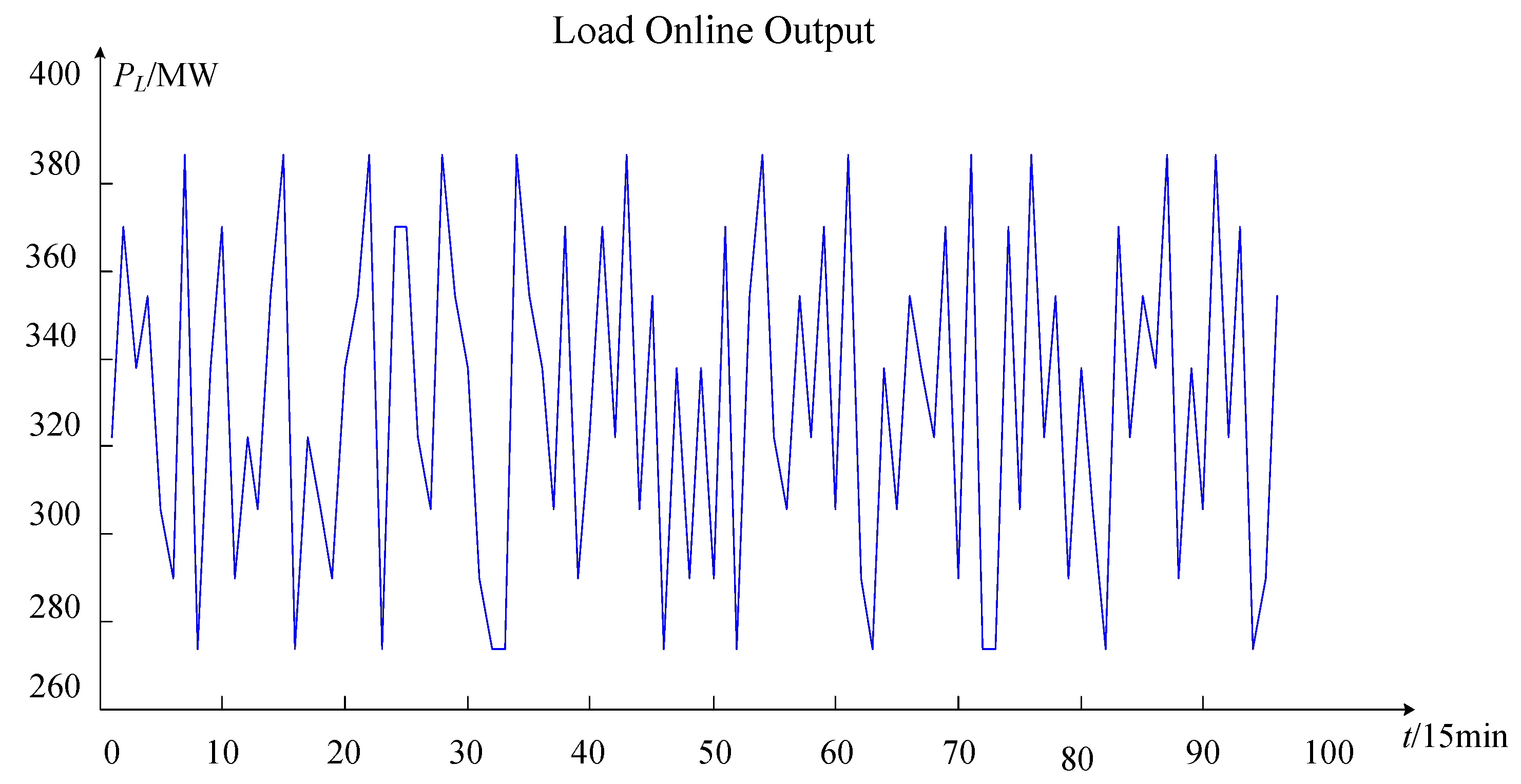
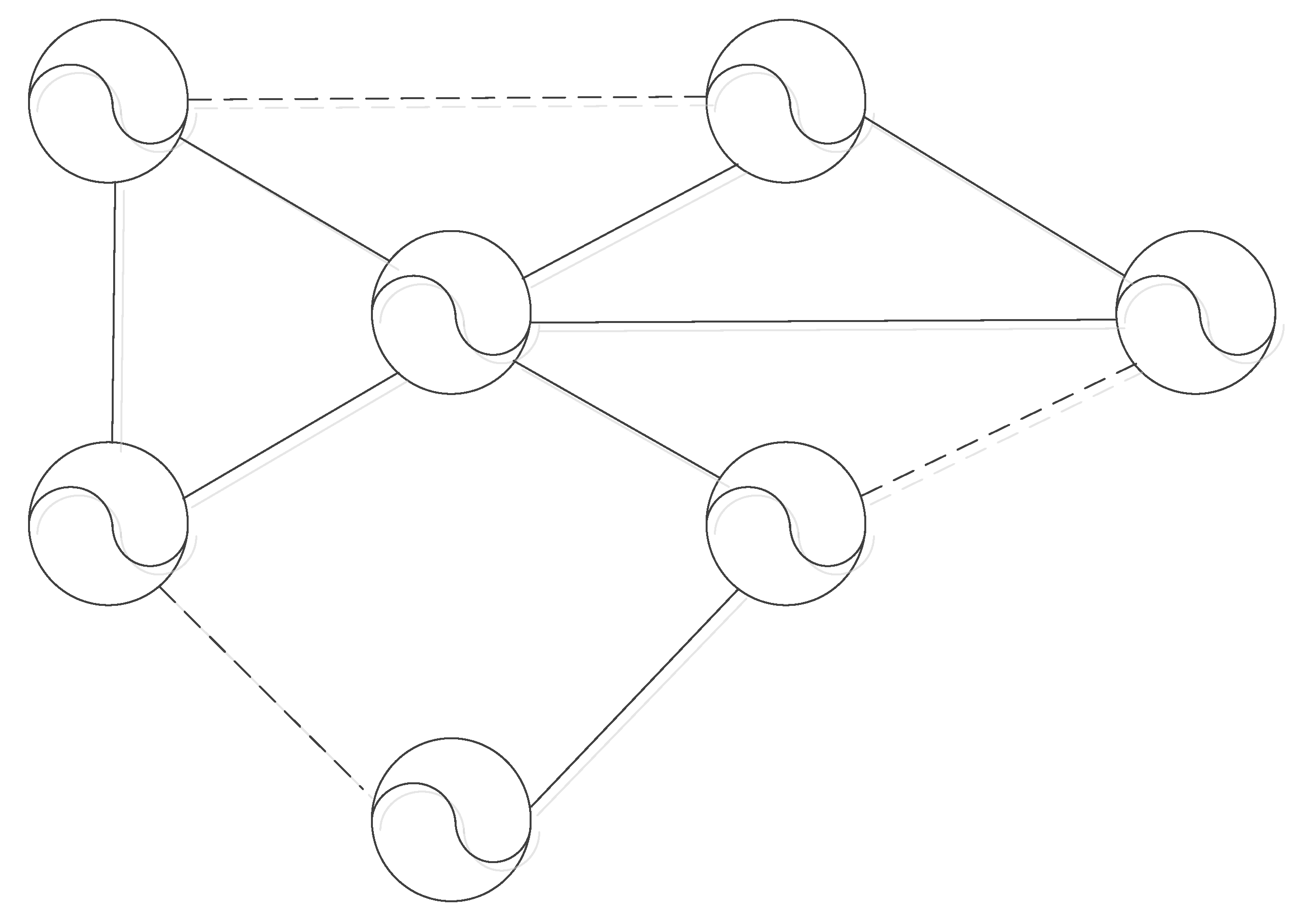

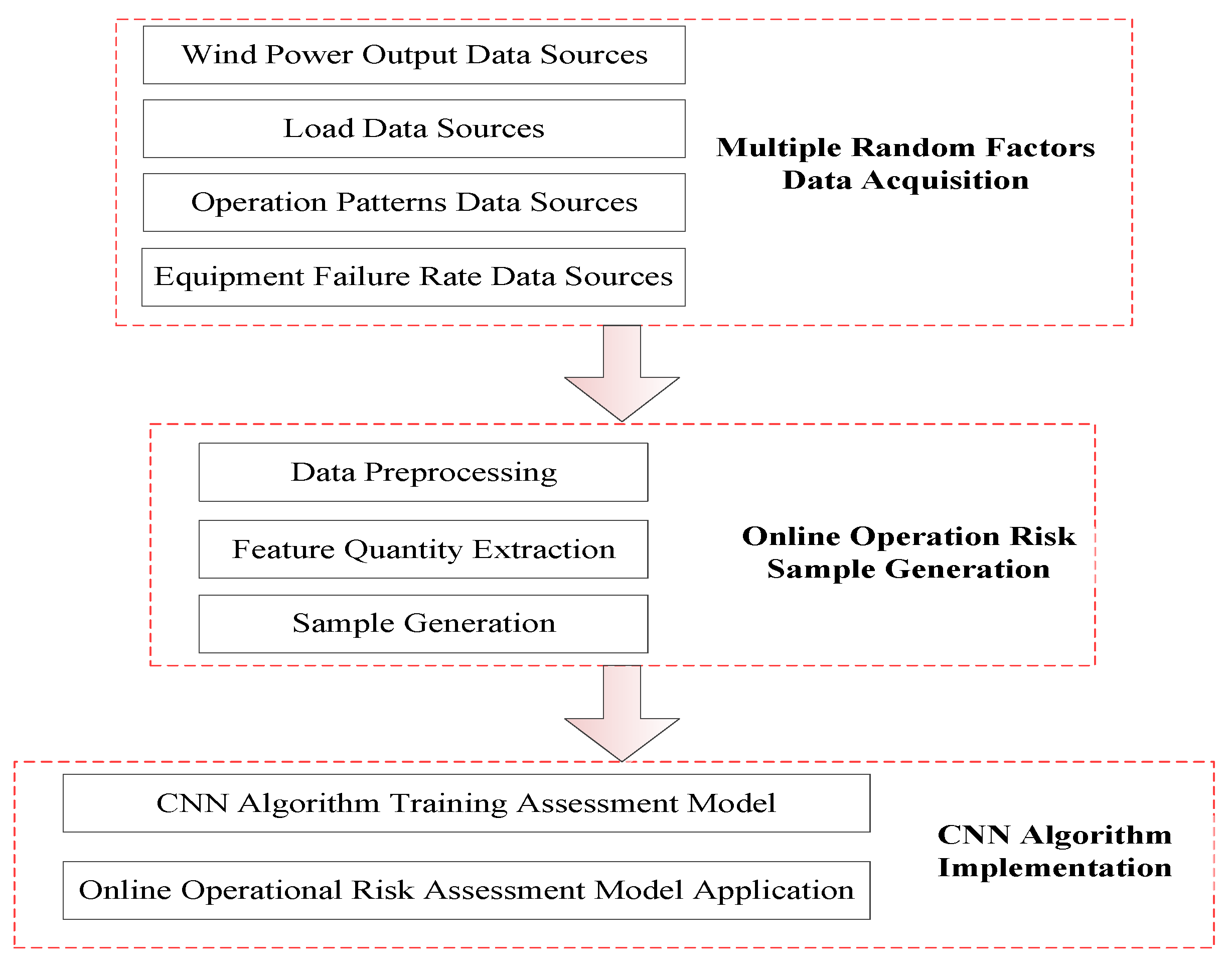
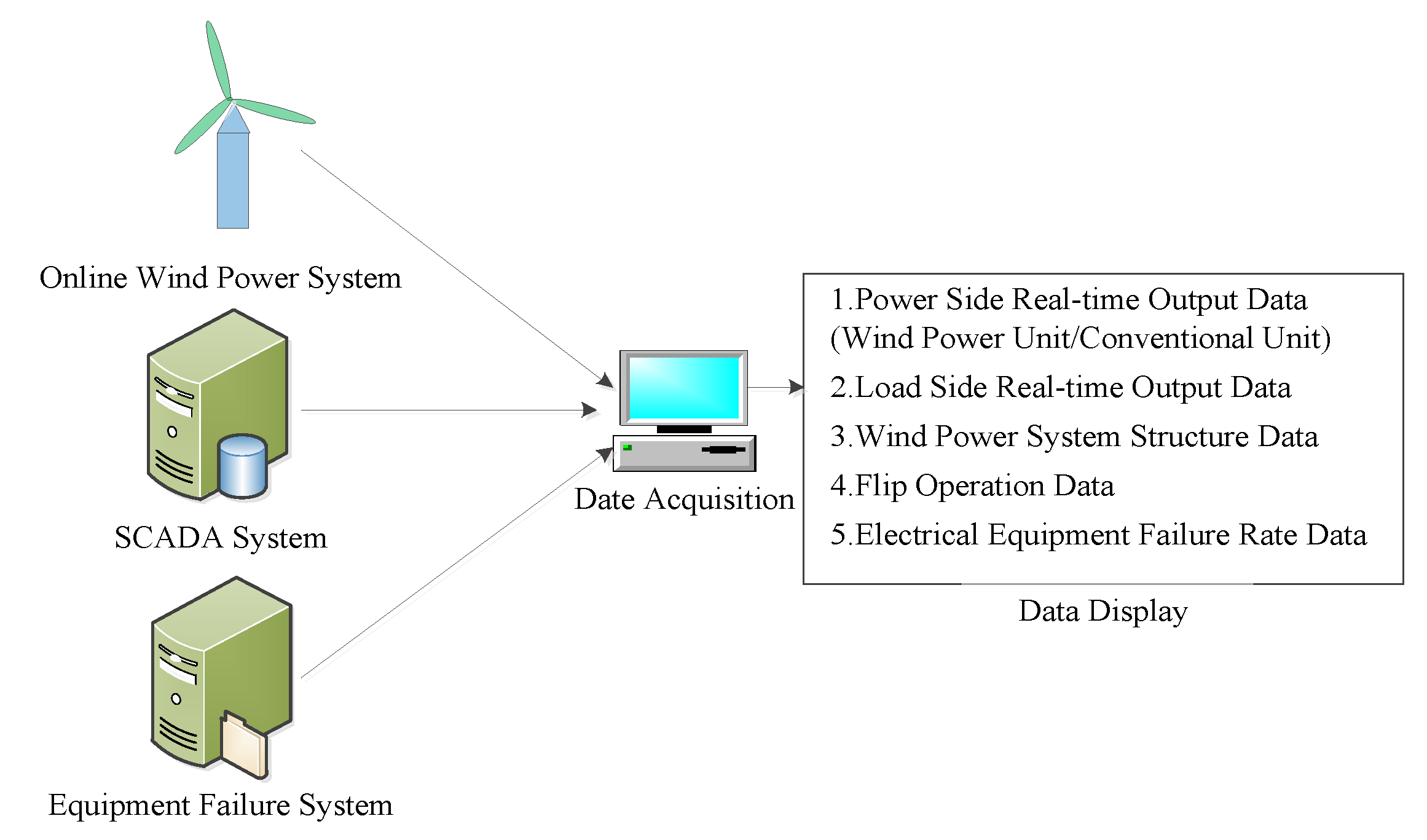
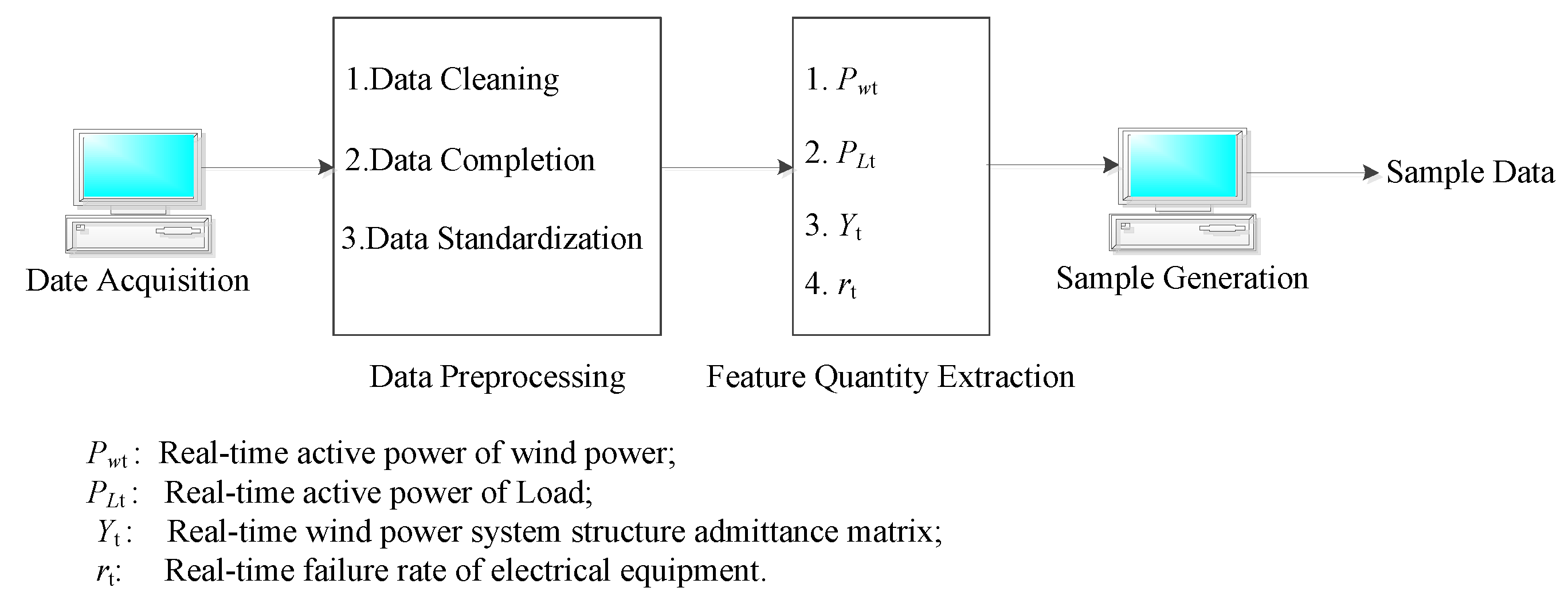
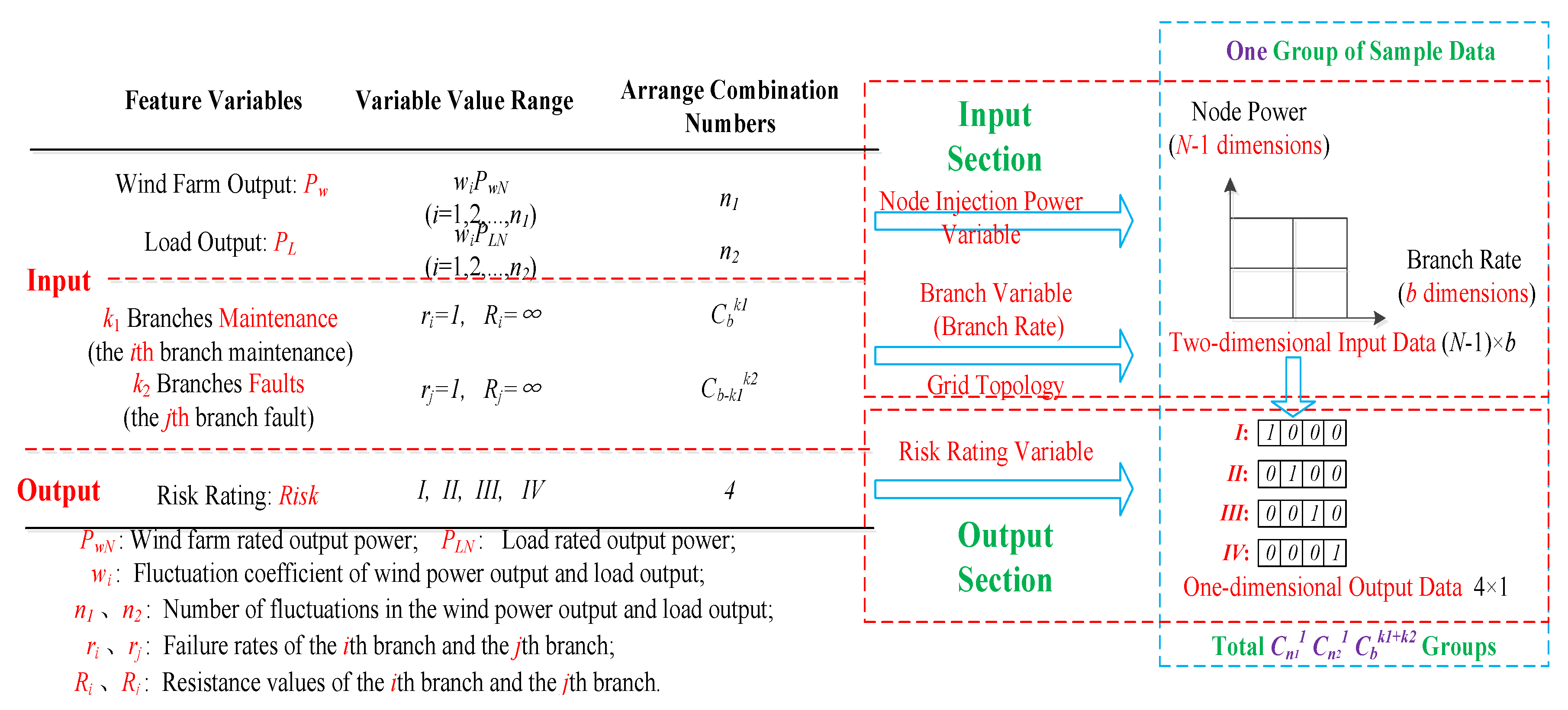
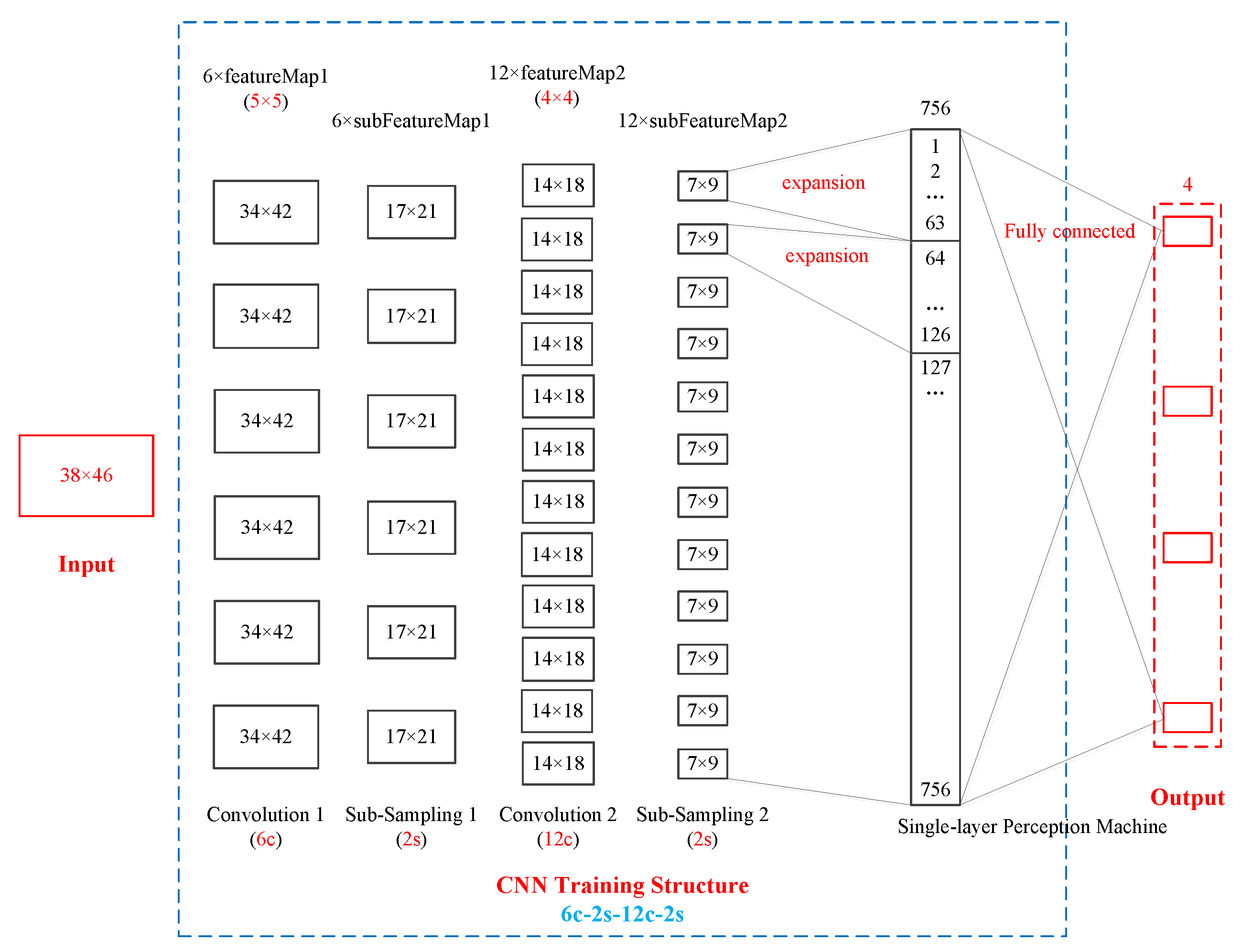

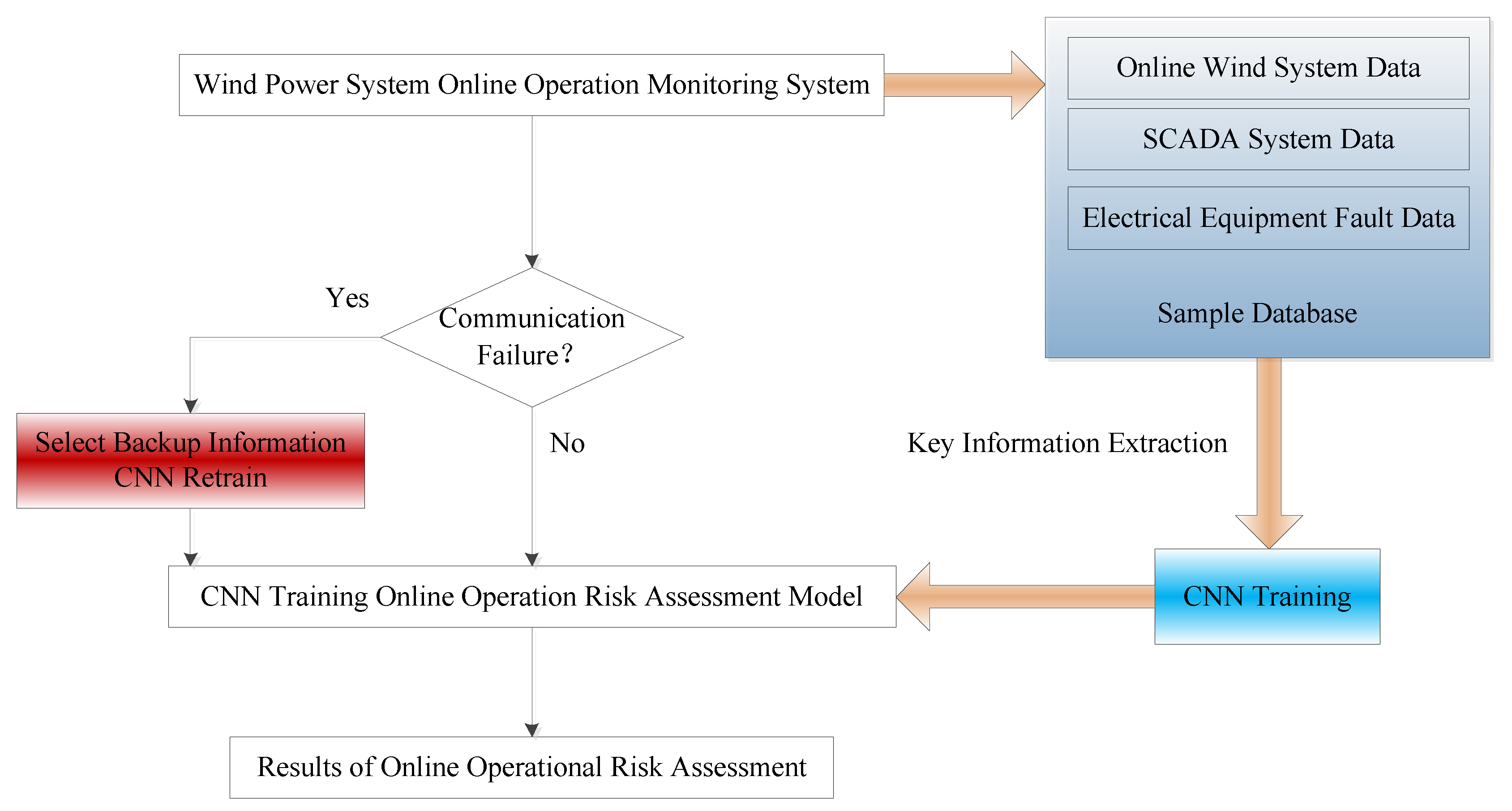
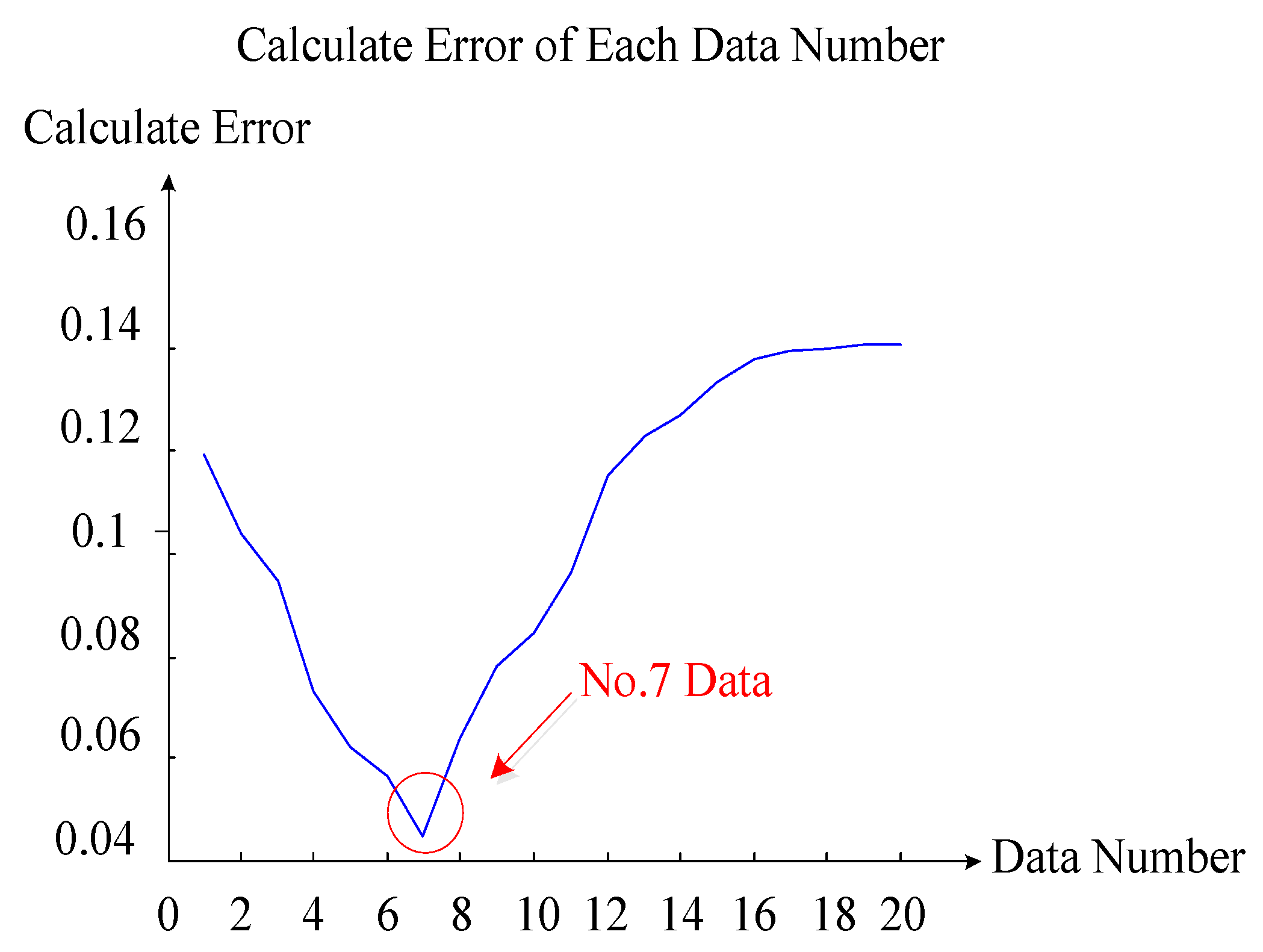

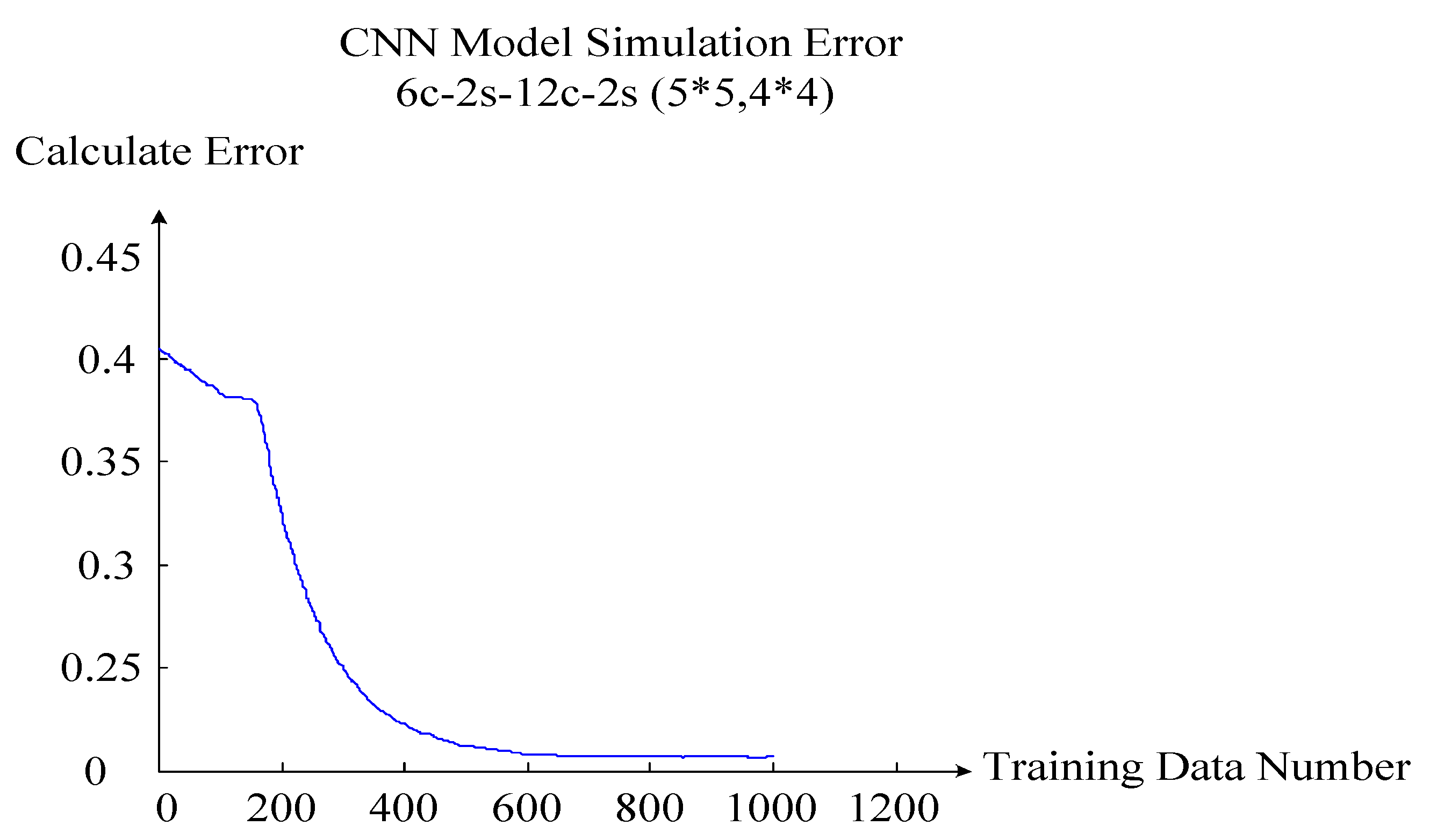
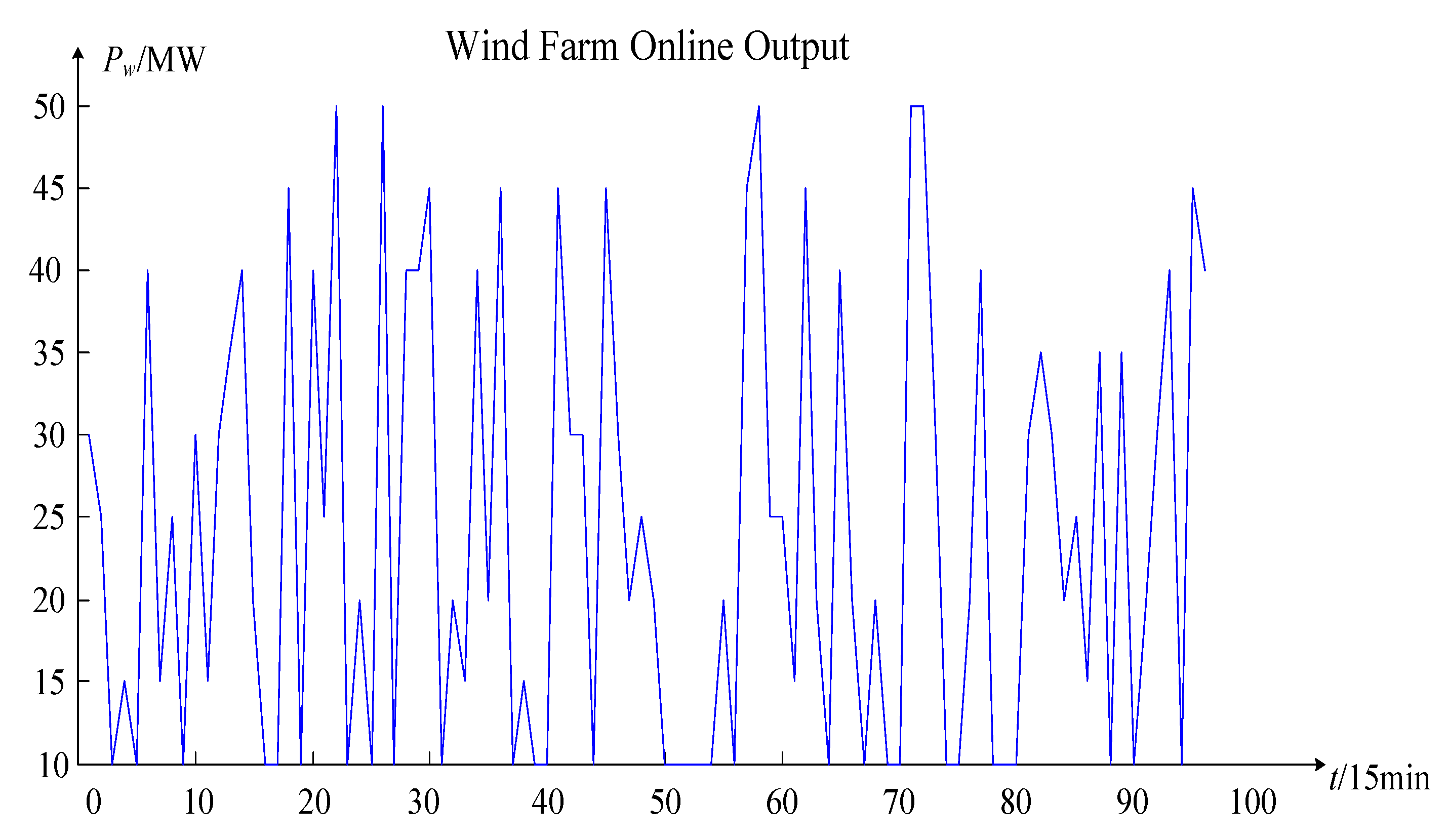

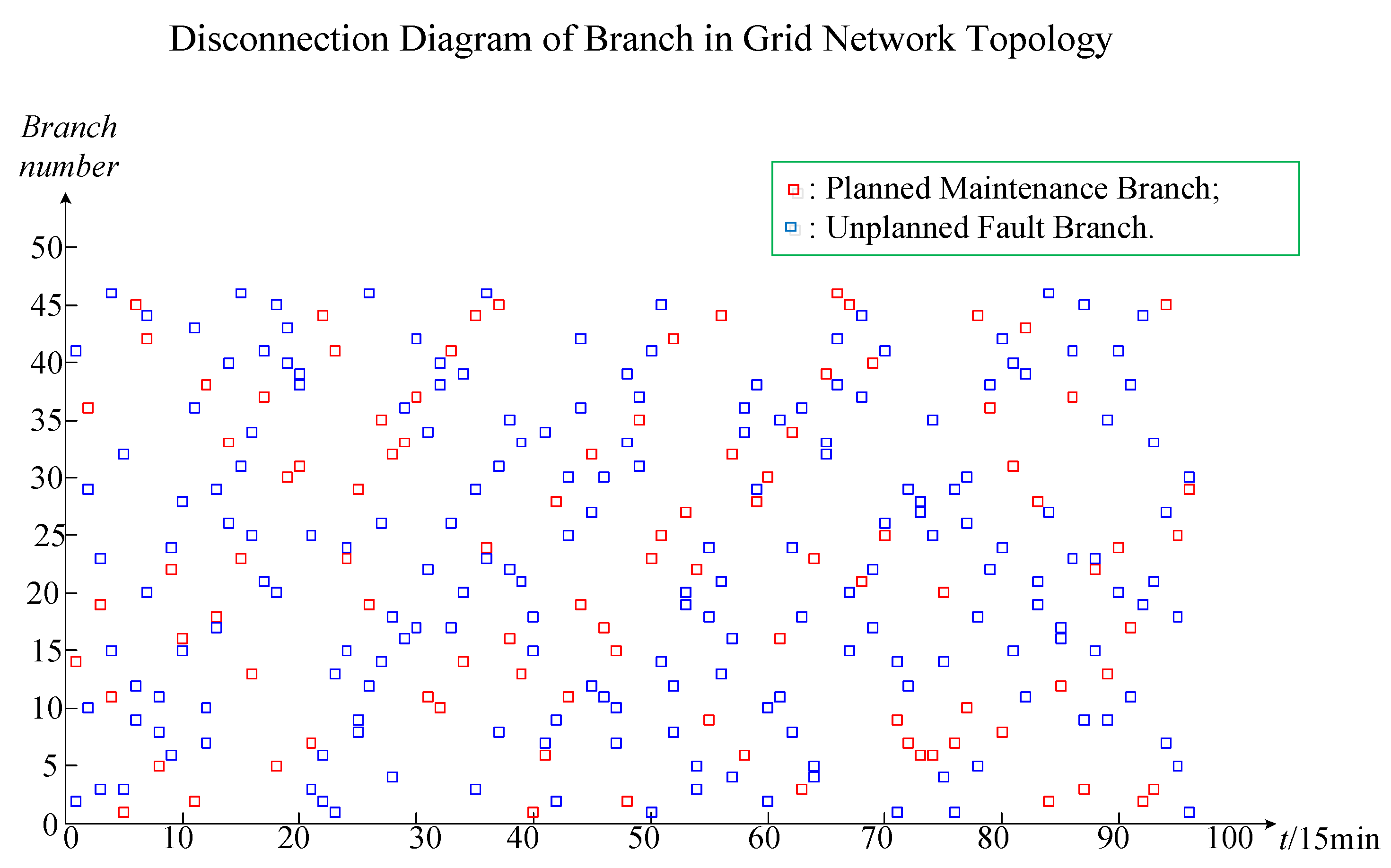
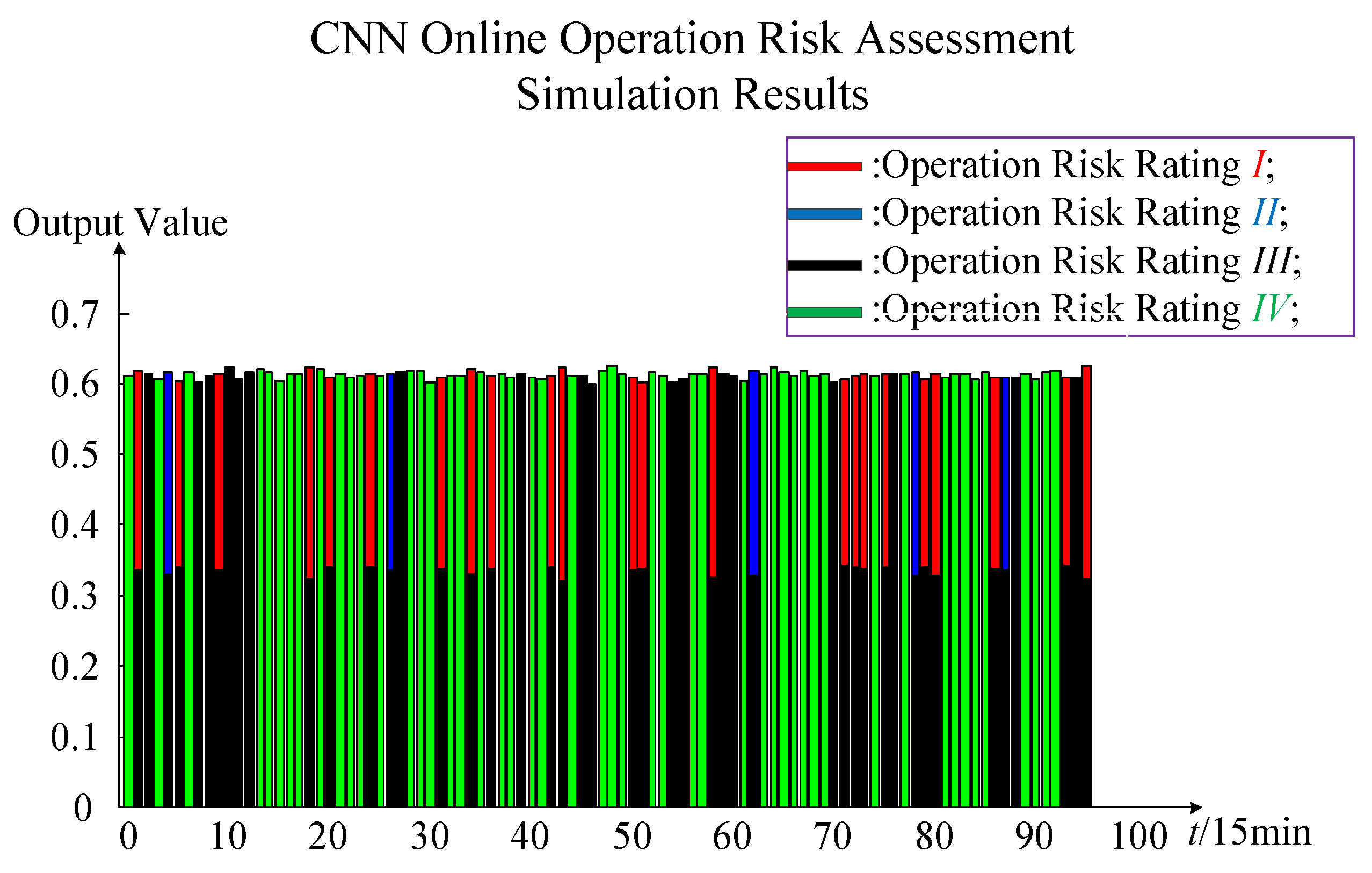

| Risk Rating | General Accidents | Larger Accidents | Major Accidents | Particularly Significant Accidents |
|---|---|---|---|---|
| Ki Range | <7% | 7–10% | 10–30% | >30% |
| Symbol | I | II | III | IV |
| Feature Variables | Variable Value Range | Arranged Combination Numbers |
|---|---|---|
| Wind Farm Output Pw | (0.2/0.3/0.4/0.5/0.6/0.7/0.8/0.9/1.0) * 50 MW | 9 kinds |
| Load Output PL | (0.8/0.85/0.9/0.95/1.0/1.05/1.1/1.15/1.2) * PLN | 9 kinds |
| Planned Maintenance | ri1 = 1, Ri1 = ∞Ω | C461 = 46 kinds |
| Unplanned Equipment Failure | rj1 = 1, Rj1 = ∞Ω; rj2 = 1, Rj2 = ∞Ω | C452 = 990 kinds |
| Risk Rating | I, II, III, IV | 4 kinds |
| Input/Groups | Output/Groups | |
|---|---|---|
| Training Data | 38 × 46 × 50,000 | 4 × 50,000 |
| Test Data | 38 × 46 × 10,000 | 4 × 10,000 |
| Project | Parameter |
|---|---|
| System Version | Windows 10 Pro. 64-bit |
| CPU | Intel(R) Core (TM) i5-6200U |
| Processing Speed | 2.40 GHz |
| RAM | 8 GB |
| No. | Network Structure | Convolution Core | Batch Number | Training Time | Calculate Error Rate | Training Time/s |
|---|---|---|---|---|---|---|
| 1 | 6c-1s-12c-1s | 3 * 3, 3 * 3 | 50 | 2 | 0.6776 | 471.331 |
| 2 | 6c-1s-12c-1s | 5 * 5, 5 *5 | 50 | 2 | 0.3402 | 661.027 |
| 3 | 6c-1s-12c-1s | 7 * 7, 7 * 7 | 50 | 2 | 0.6776 | 967.433 |
| 4 | 6c-1s-12c-1s | 4 * 4, 5 * 5 | 50 | 2 | 0.0402 | 661.670 |
| 5 | 6c-1s-12c-2s | 4* 4, 4 * 4 | 50 | 2 | 0.3402 | 440.17 |
| 6 | 6c-1s-12c-2s | 5 * 5, 5 * 5 | 50 | 2 | 0.6776 | 608.454 |
| 7 | 6c-2s-12c-1s | 5* 5, 5 * 5 | 50 | 2 | 0.3402 | 248.144 |
| 8 | 6c-2s-12c-1s | 5 * 5, 4 * 4 | 50 | 2 | 0.3204 | 202.517 |
| 9 | 6c-2s-12c-2s | 5* 5, 4 * 4 | 50 | 2 | 0.0016 | 197.475 |
| 10 | 6c-2s-12c-2s | 7 * 7, 5* 5 | 50 | 2 | 0.0502 | 278.023 |
| 11 | 1c-1s-1c-1s | 1 * 1, 1 * 1 | 50 | 2 | 0.3205 | 10.395 |
| 12 | 6c-1s-12c-1s | 4 * 4, 4 * 4 | 100 | 2 | 0.3402 | 575.209 |
| 13 | 6c-1s-12c-1s | 4* 4, 4 * 4 | 500 | 2 | 0.3102 | 580.214 |
| 14 | 6c-1s-12c-1s | 4* 4, 4 * 4 | 50 | 10 | 0.3402 | 296.052 |
| 15 | 6c-2s-12c-2s | 5 * 5, 4 * 4 | 50 | 10 | 0.0010 | 287.563 |
| 16 | 6c-2s-12c-2s | 5 * 5, 4 * 4 | 500 | 10 | 0.0021 | 190.264 |
| Elapsed Time | |
|---|---|
| Apply CNN Model | 0.181 s |
| Regular Assessment Model | 297.315 s |
© 2019 by the authors. Licensee MDPI, Basel, Switzerland. This article is an open access article distributed under the terms and conditions of the Creative Commons Attribution (CC BY) license (http://creativecommons.org/licenses/by/4.0/).
Share and Cite
Gong, Q.; Tan, S.; Wang, Y.; Liu, D.; Qiao, H.; Wu, L. Online Operation Risk Assessment of the Wind Power System of the Convolution Neural Network (CNN) Considering Multiple Random Factors. Processes 2019, 7, 464. https://doi.org/10.3390/pr7070464
Gong Q, Tan S, Wang Y, Liu D, Qiao H, Wu L. Online Operation Risk Assessment of the Wind Power System of the Convolution Neural Network (CNN) Considering Multiple Random Factors. Processes. 2019; 7(7):464. https://doi.org/10.3390/pr7070464
Chicago/Turabian StyleGong, Qingwu, Si Tan, Yubo Wang, Dong Liu, Hui Qiao, and Liuchuang Wu. 2019. "Online Operation Risk Assessment of the Wind Power System of the Convolution Neural Network (CNN) Considering Multiple Random Factors" Processes 7, no. 7: 464. https://doi.org/10.3390/pr7070464
APA StyleGong, Q., Tan, S., Wang, Y., Liu, D., Qiao, H., & Wu, L. (2019). Online Operation Risk Assessment of the Wind Power System of the Convolution Neural Network (CNN) Considering Multiple Random Factors. Processes, 7(7), 464. https://doi.org/10.3390/pr7070464




